ERLENBACH - A TOWN WITH A HECTIC HISTORY :
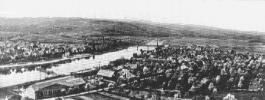 The old Erlenbach around 1920/30s
The old Erlenbach around 1920/30s
When the region was taken over by hummans, lies in the dark of history. In 1876 for the first time traces of a previous colonization appeared in daylight
for the first time. North of Hermann Staudinger High School, four "Bronze Age" burial mounds were found (about 1550-1250 BC). In 1981 then, in gardens
near the hospital, two tombs of urn typical of the time of 1000-800 B. C. The two fortuitous discoveries give no answer to the question, if there was already
a solid colonization at that time. It is more likely that nomadic groups of people buried their dead here.
WHEN THE ROMANS WENT, THE FRANKS CAME :
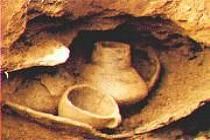 Incidental discovery of a tomb, found during gardenings
Incidental discovery of a tomb, found during gardenings
near the hospital, dated 1000-800 before Chr.
During the first century of our chronology the Roman Imperium extended to the Main River. The wet limes, the eastern border of the Imperium, was guaranteed
with Roman forts. To avoid the Romans, Germanic trunks on the other side of the Main relocated their habitats to the east. When the Roman Imperium was about
to dissolve, it had to spend many more years until the Franks in 531 advanced into the Main Valley and in turn founded colonizations. The first farms in
Erlenbach were probably built between 800 and 900 after Chr. Foundations of a building from that time came to light in the middle of the last century during
the construction of the Erlenbach railway bridge on the bank of the river Main.
THE COAT OF ARMS OF ERLENBACH :
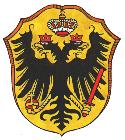 The coat of arms of Erlenbach am Main
The coat of arms of Erlenbach am Main
Around 1183, Emperor Friedrich Barbarossa gave the town of Erlenbach »market justice«. This imperial distinction was expressed optically
with a special sign. This one shows a large cross, on the tip of which there is a rooster. On the transverse beam, one hand rises to one side and a sword
to the other side. The hand showing above made it clear that the inhabitants of Erlenbach were under the particular protection of an emperor and that
everyone had to expect whoever contravened this, perhaps executed by the sword of the ruler. The cock on the tip of the cross rarely appears extremely
rarely under the imperial symbols of that time. The coat of arms, given again in 1953 to the market town Erlenbach a. Main in 1953, is clearly based on two seals
of Erlenbach village justice, dating from 1722-1810, with corresponding images. The two Typars (these are stamps of seal, mostly in metal) showed a
crowned double-headed eagle holding in the claws on the right the imperial apple with the cross and in the claws on the left a sword. On the eagles'
heads floated a hat of an elector prince. Below the eagle heads were the letters E and B »Erlenbach«.
(Markt = market town / that's a kind of honorary title, which underlines and appreciates the importance of the municipality.)
AWARDING MARKET JUSTICE :
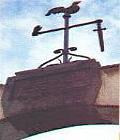 The sign of market justice
The sign of market justice
When the emperor Friedrich Barbarossa gave Erlenbach 1183 the "market justice", is not proved by documents. The oral tradition says, that the
courageous inhabitants of Erlenbach saved the emperor at that time life and he thanked himself for this with this high distinction. The first
documentary mention of Erlenbach followed shortly afterwards. It is dated in 1236 and informs the transfer of the patronage rights of the church
of Erlenbach to the Cistercian nuns in Himmelthal nunnery. The documents of the following centuries relate only to daily life. But life in the village
did not always flow quietly. Also in Erlenbach the plague wreaks havoc, and here, too, brave inhabitants of Erlenbach gave their lives on the pyres
of the inquisition.
ERLENBACH UNDER "DIFFERENT SOVEREIGNS" :
For centuries, Erlenbach was under the rule of Mainz, which has ended only in the early 19th century. From 1803 onwards, the village first belonged
to the Principality of Aschaffenburg, later to the Grand Duchy of Frankfurt. In 1814, Erlenbach was even a part of Austria before it was finally
definitively attributed to the Bavarian kingdom.
Since the treaties of Paris in 1814 the commune belongs to Bavaria. The administration of the Erzstift Mainz became part of the new principality
of Aschaffenburg in 1803 by decision of the imperial deputation (=Reichsdeputationshauptschluss) in 1803 and by this decision (at that time a department
of the Grand Duchy of Frankfurt) finally became part of the Kingdom of Bavaria in 1814.
FROM A COMMUNE TO A TOWN :
In 1918, Erlenbach is ready for the industrial century. The shipyard moves its activities from Wörth to Erlenbach, and the Glanzstoff-Werke factory
is already bringing work and bread to many people. A few years after the Second World War, Erlenbach was already regarded as "the richest town
in Bavaria". Thanks to the common industry tax payments, it was already possible for the municipality to build an extraordinary and efficient
infrastructure early on. State recognition is not long overdue. In 1955, Erlenbach became a Markt (market town) and in 1970 the market town was
raised to a town. Together with the district hospital and the first classical high school in the old rural district Obernburg there are now also
significant institutions in Erlenbach. With the town of Obernburg and the market town Elsenfeld is Erlenbach determined, within the framework of
country planning, as a centre of means.

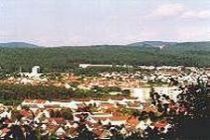

Erlenbach a.Main from its most beautiful side